Abstract
2,3,7,8-Tetrachlorodibenzo-p-dioxin (TCDD) and structurally similar halogenated aromatic hydrocarbons cause a broad range of immunologic effects in experimental animals including decreased host resistance to infectious disease and suppressed humoral and cell-mediated immune responses. In the mouse, TCDD immunotoxicity has been shown to be an aryl hydrocarbon (Ah) receptor-dependent process. However, despite considerable research, the biochemical and molecular alterations that occur subsequent to Ah receptor activation that lead to altered immune reactivity remain to be elucidated. In addition to immune suppression, TCDD promotes inflammatory responses. This effect may result from an upregulation of the production of inflammatory cytokines such as interleukin-1 and tumor necrosis factor. Nonhuman primates exposed to TCDD show suppressed antibody responses and changes in lymphocyte subsets in the peripheral blood. The immunotoxic effects of TCDD in humans are poorly characterized, and few studies have examined the immune status of individuals with known, documented exposure to TCDD. It is important for laboratory research to focus on defining TCDD-sensitive immunologic biomarkers in animal models that can also be used in human subjects. Understanding the mechanisms that underlie species differences in TCDD immunotoxicity is also of critical importance for extrapolation of effects seen in laboratory animals to man.
Full text
PDF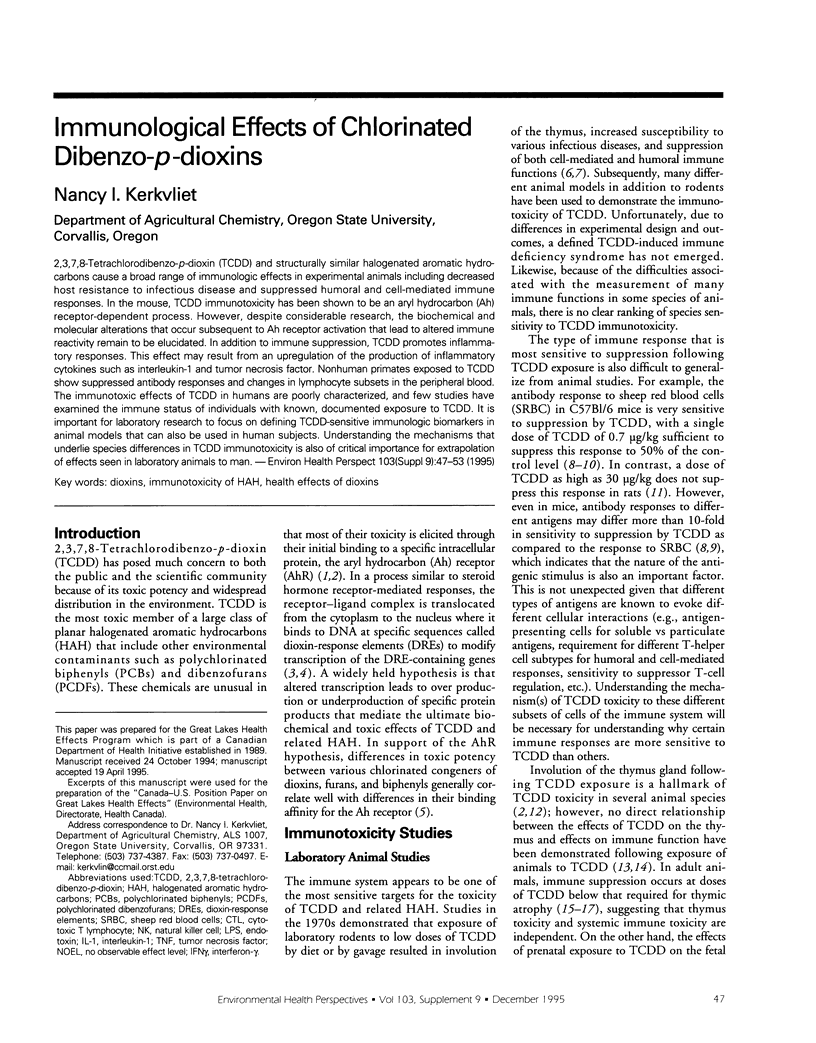
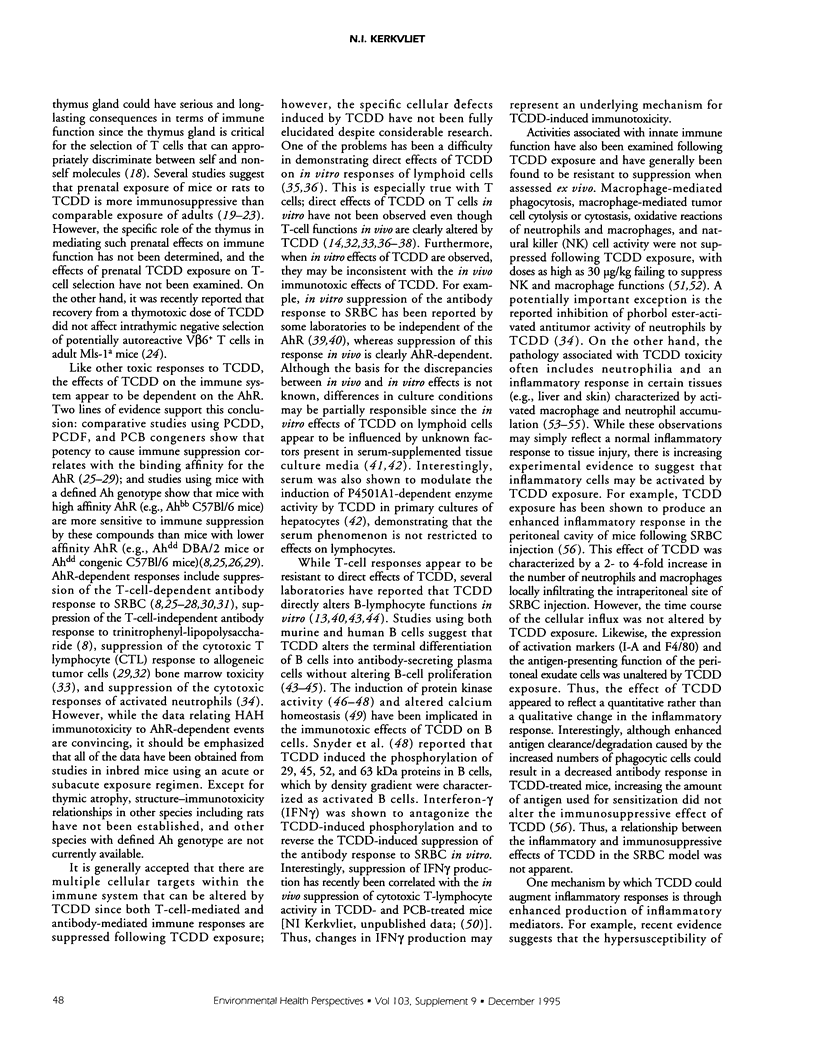
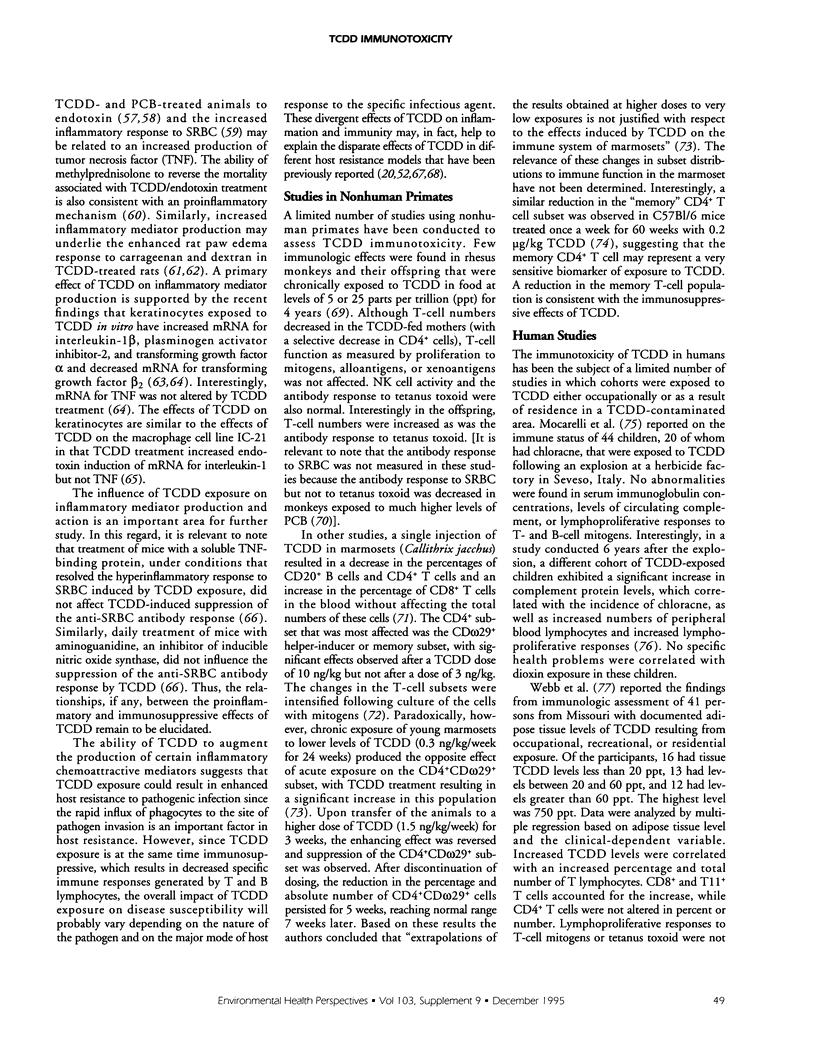
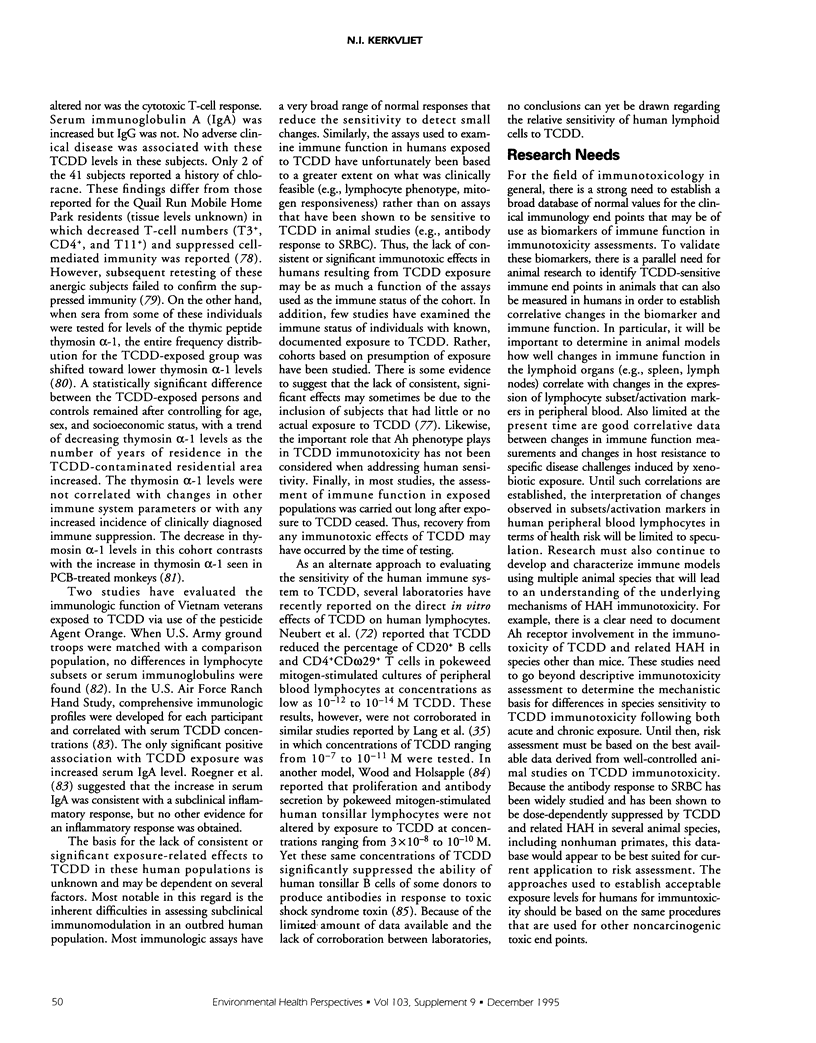
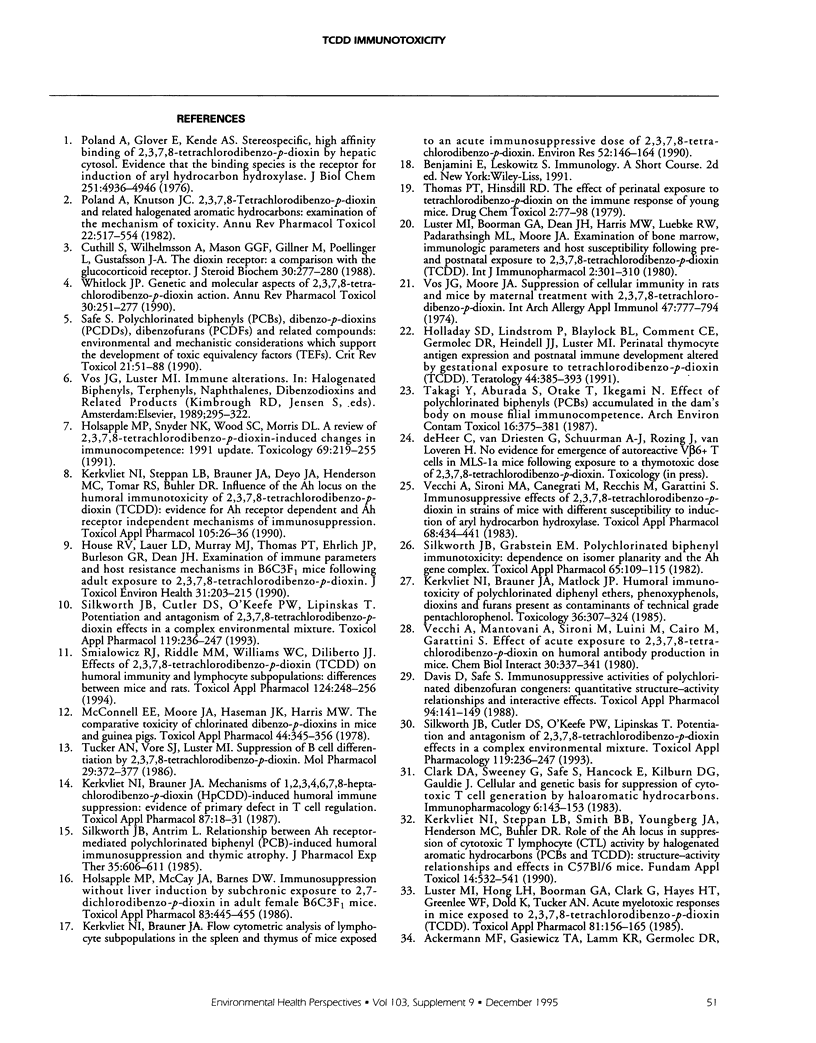
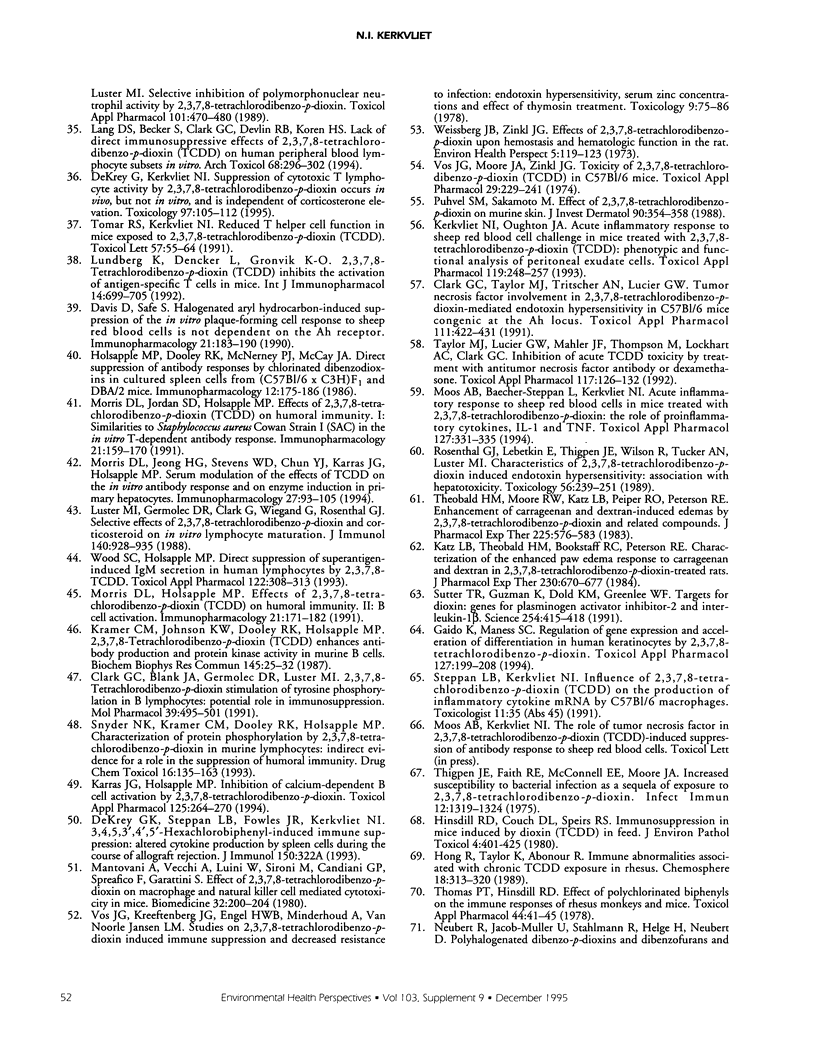
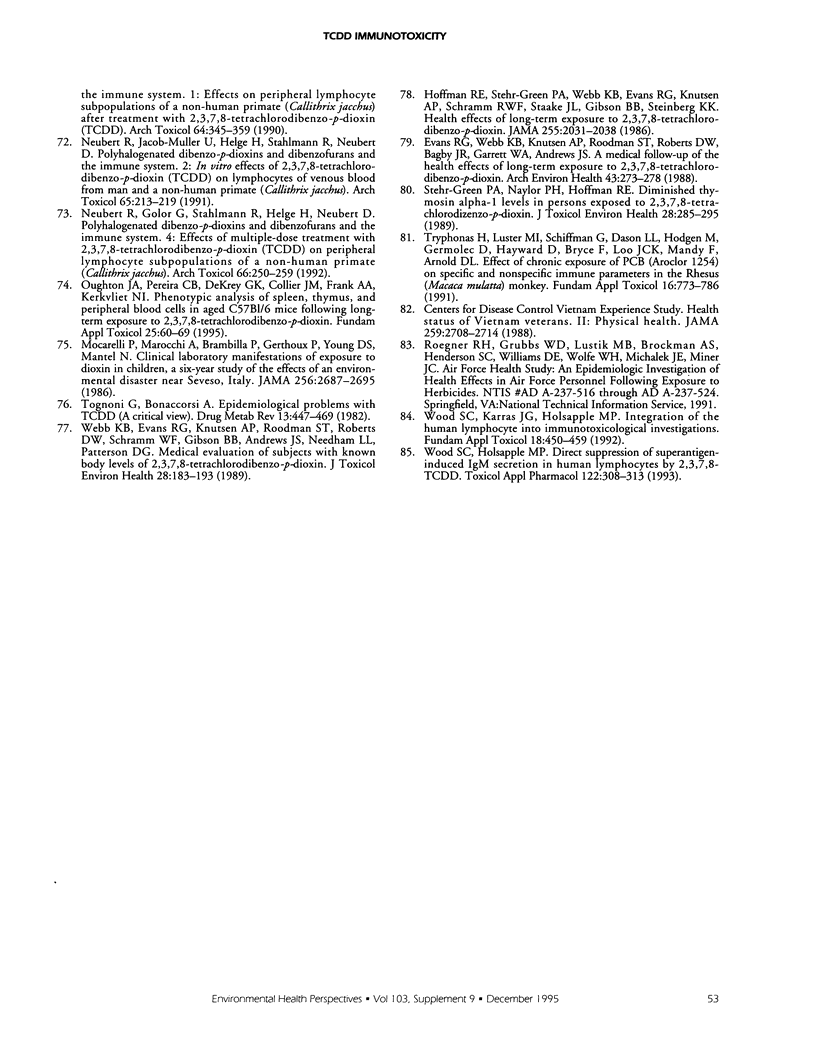
Selected References
These references are in PubMed. This may not be the complete list of references from this article.
- Ackermann M. F., Gasiewicz T. A., Lamm K. R., Germolec D. R., Luster M. I. Selective inhibition of polymorphonuclear neutrophil activity by 2,3,7,8-tetrachlorodibenzo-p-dioxin. Toxicol Appl Pharmacol. 1989 Dec;101(3):470–480. doi: 10.1016/0041-008x(89)90195-6. [DOI] [PubMed] [Google Scholar]
- Clark D. A., Sweeney G., Safe S., Hancock E., Kilburn D. G., Gauldie J. Cellular and genetic basis for suppression of cytotoxic T cell generation by haloaromatic hydrocarbons. Immunopharmacology. 1983 Aug;6(2):143–153. doi: 10.1016/0162-3109(83)90007-3. [DOI] [PubMed] [Google Scholar]
- Clark G. C., Blank J. A., Germolec D. R., Luster M. I. 2,3,7,8-Tetrachlorodibenzo-p-dioxin stimulation of tyrosine phosphorylation in B lymphocytes: potential role in immunosuppression. Mol Pharmacol. 1991 Apr;39(4):495–501. [PubMed] [Google Scholar]
- Clark G. C., Taylor M. J., Tritscher A. M., Lucier G. W. Tumor necrosis factor involvement in 2,3,7,8-tetrachlorodibenzo-p-dioxin-mediated endotoxin hypersensitivity in C57BL/6J mice congenic at the Ah locus. Toxicol Appl Pharmacol. 1991 Dec;111(3):422–431. doi: 10.1016/0041-008x(91)90247-c. [DOI] [PubMed] [Google Scholar]
- Cuthill S., Wilhelmsson A., Mason G. G., Gillner M., Poellinger L., Gustafsson J. A. The dioxin receptor: a comparison with the glucocorticoid receptor. J Steroid Biochem. 1988;30(1-6):277–280. doi: 10.1016/0022-4731(88)90106-9. [DOI] [PubMed] [Google Scholar]
- Davis D., Safe S. Halogenated aryl hydrocarbon-induced suppression of the in vitro plaque-forming cell response to sheep red blood cells is not dependent on the Ah receptor. Immunopharmacology. 1991 May-Jun;21(3):183–190. doi: 10.1016/0162-3109(91)90023-r. [DOI] [PubMed] [Google Scholar]
- Davis D., Safe S. Immunosuppressive activities of polychlorinated dibenzofuran congeners: quantitative structure-activity relationships and interactive effects. Toxicol Appl Pharmacol. 1988 Jun 15;94(1):141–149. doi: 10.1016/0041-008x(88)90344-4. [DOI] [PubMed] [Google Scholar]
- De Krey G. K., Kerkvliet N. I. Suppression of cytotoxic T lymphocyte activity by 2,3,7,8-tetrachlorodibenzo-p-dioxin occurs in vivo, but not in vitro, and is independent of corticosterone elevation. Toxicology. 1995 Mar 31;97(1-3):105–112. doi: 10.1016/0300-483x(94)02929-o. [DOI] [PubMed] [Google Scholar]
- Evans R. G., Webb K. B., Knutsen A. P., Roodman S. T., Roberts D. W., Bagby J. R., Garrett W. A., Jr, Andrews J. S., Jr A medical follow-up of the health effects of long-term exposure to 2,3,7,8-tetrachlorodibenzo-p-dioxin. Arch Environ Health. 1988 Jul-Aug;43(4):273–278. doi: 10.1080/00039896.1988.10545949. [DOI] [PubMed] [Google Scholar]
- Gaido K. W., Maness S. C. Regulation of gene expression and acceleration of differentiation in human keratinocytes by 2,3,7,8-tetrachlorodibenzo-p-dioxin. Toxicol Appl Pharmacol. 1994 Aug;127(2):199–208. doi: 10.1006/taap.1994.1154. [DOI] [PubMed] [Google Scholar]
- Hinsdill R. D., Couch D. L., Speirs R. S. Immunosuppression in mice induced by dioxin (TCDD) in feed. J Environ Pathol Toxicol. 1980 Sep;4(2-3):401–425. [PubMed] [Google Scholar]
- Hoffman R. E., Stehr-Green P. A., Webb K. B., Evans R. G., Knutsen A. P., Schramm W. F., Staake J. L., Gibson B. B., Steinberg K. K. Health effects of long-term exposure to 2,3,7,8-tetrachlorodibenzo-p-dioxin. JAMA. 1986 Apr 18;255(15):2031–2038. [PubMed] [Google Scholar]
- Holladay S. D., Lindstrom P., Blaylock B. L., Comment C. E., Germolec D. R., Heindell J. J., Luster M. I. Perinatal thymocyte antigen expression and postnatal immune development altered by gestational exposure to tetrachlorodibenzo-p-dioxin (TCDD). Teratology. 1991 Oct;44(4):385–393. doi: 10.1002/tera.1420440405. [DOI] [PubMed] [Google Scholar]
- Holsapple M. P., Dooley R. K., McNerney P. J., McCay J. A. Direct suppression of antibody responses by chlorinated dibenzodioxins in cultured spleen cells from (C57BL/6 x C3H)F1 and DBA/2 mice. Immunopharmacology. 1986 Dec;12(3):175–186. doi: 10.1016/0162-3109(86)90001-9. [DOI] [PubMed] [Google Scholar]
- Holsapple M. P., McCay J. A., Barnes D. W. Immunosuppression without liver induction by subchronic exposure to 2,7-dichlorodibenzo-p-dioxin in adult female B6C3F1 mice. Toxicol Appl Pharmacol. 1986 May;83(3):445–455. doi: 10.1016/0041-008x(86)90227-9. [DOI] [PubMed] [Google Scholar]
- Holsapple M. P., Snyder N. K., Wood S. C., Morris D. L. A review of 2,3,7,8-tetrachlorodibenzo-p-dioxin-induced changes in immunocompetence: 1991 update. Toxicology. 1991;69(3):219–255. doi: 10.1016/0300-483x(91)90184-3. [DOI] [PubMed] [Google Scholar]
- House R. V., Lauer L. D., Murray M. J., Thomas P. T., Ehrlich J. P., Burleson G. R., Dean J. H. Examination of immune parameters and host resistance mechanisms in B6C3F1 mice following adult exposure to 2,3,7,8-tetrachlorodibenzo-p-dioxin. J Toxicol Environ Health. 1990 Nov;31(3):203–215. doi: 10.1080/15287399009531449. [DOI] [PubMed] [Google Scholar]
- Karras J. G., Holsapple M. P. Inhibition of calcium-dependent B cell activation by 2,3,7,8-tetrachlorodibenzo-p-dioxin. Toxicol Appl Pharmacol. 1994 Apr;125(2):264–270. doi: 10.1006/taap.1994.1072. [DOI] [PubMed] [Google Scholar]
- Katz L. B., Theobald H. M., Bookstaff R. C., Peterson R. E. Characterization of the enhanced paw edema response to carrageenan and dextran in 2,3,7,8-tetrachlorodibenzo-p-dioxin-treated rats. J Pharmacol Exp Ther. 1984 Sep;230(3):670–677. [PubMed] [Google Scholar]
- Kerkvliet N. I., Baecher-Steppan L., Smith B. B., Youngberg J. A., Henderson M. C., Buhler D. R. Role of the Ah locus in suppression of cytotoxic T lymphocyte activity by halogenated aromatic hydrocarbons (PCBs and TCDD): structure-activity relationships and effects in C57Bl/6 mice congenic at the Ah locus. Fundam Appl Toxicol. 1990 Apr;14(3):532–541. doi: 10.1016/0272-0590(90)90257-k. [DOI] [PubMed] [Google Scholar]
- Kerkvliet N. I., Brauner J. A. Flow cytometric analysis of lymphocyte subpopulations in the spleen and thymus of mice exposed to an acute immunosuppressive dose of 2,3,7,8-tetrachlorodibenzo-p-dioxin (TCDD). Environ Res. 1990 Aug;52(2):146–154. doi: 10.1016/s0013-9351(05)80249-x. [DOI] [PubMed] [Google Scholar]
- Kerkvliet N. I., Brauner J. A., Matlock J. P. Humoral immunotoxicity of polychlorinated diphenyl ethers, phenoxyphenols, dioxins and furans present as contaminants of technical grade pentachlorophenol. Toxicology. 1985 Sep;36(4):307–324. doi: 10.1016/0300-483x(85)90033-2. [DOI] [PubMed] [Google Scholar]
- Kerkvliet N. I., Brauner J. A. Mechanisms of 1,2,3,4,6,7,8-heptachlorodibenzo-p-dioxin (HpCDD)-induced humoral immune suppression: evidence of primary defect in T-cell regulation. Toxicol Appl Pharmacol. 1987 Jan;87(1):18–31. doi: 10.1016/0041-008x(87)90080-9. [DOI] [PubMed] [Google Scholar]
- Kerkvliet N. I., Oughton J. A. Acute inflammatory response to sheep red blood cell challenge in mice treated with 2,3,7,8-tetrachlorodibenzo-p-dioxin (TCDD): phenotypic and functional analysis of peritoneal exudate cells. Toxicol Appl Pharmacol. 1993 Apr;119(2):248–257. doi: 10.1006/taap.1993.1066. [DOI] [PubMed] [Google Scholar]
- Kerkvliet N. I., Steppan L. B., Brauner J. A., Deyo J. A., Henderson M. C., Tomar R. S., Buhler D. R. Influence of the Ah locus on the humoral immunotoxicity of 2,3,7,8-tetrachlorodibenzo-p-dioxin: evidence for Ah-receptor-dependent and Ah-receptor-independent mechanisms of immunosuppression. Toxicol Appl Pharmacol. 1990 Aug;105(1):26–36. doi: 10.1016/0041-008x(90)90356-y. [DOI] [PubMed] [Google Scholar]
- Kramer C. M., Johnson K. W., Dooley R. K., Holsapple M. P. 2,3,7,8-Tetrachlorodibenzo-p-dioxin (TCDD) enhances antibody production and protein kinase activity in murine B cells. Biochem Biophys Res Commun. 1987 May 29;145(1):25–33. doi: 10.1016/0006-291x(87)91282-4. [DOI] [PubMed] [Google Scholar]
- Lang D. S., Becker S., Clark G. C., Devlin R. B., Koren H. S. Lack of direct immunosuppressive effects of 2,3,7,8-tetrachlorodibenzo-p-dioxin (TCDD) on human peripheral blood lymphocyte subsets in vitro. Arch Toxicol. 1994;68(5):296–302. doi: 10.1007/s002040050072. [DOI] [PubMed] [Google Scholar]
- Lundberg K., Dencker L., Grönvik K. O. 2,3,7,8-Tetrachlorodibenzo-p-dioxin (TCDD) inhibits the activation of antigen-specific T-cells in mice. Int J Immunopharmacol. 1992 May;14(4):699–705. doi: 10.1016/0192-0561(92)90133-6. [DOI] [PubMed] [Google Scholar]
- Luster M. I., Boorman G. A., Dean J. H., Harris M. W., Luebke R. W., Padarathsingh M. L., Moore J. A. Examination of bone marrow, immunologic parameters and host susceptibility following pre- and postnatal exposure to 2,3,7,8-tetrachlorodibenzo-p-dioxin (TCDD). Int J Immunopharmacol. 1980;2(4):301–310. doi: 10.1016/0192-0561(80)90030-2. [DOI] [PubMed] [Google Scholar]
- Luster M. I., Germolec D. R., Clark G., Wiegand G., Rosenthal G. J. Selective effects of 2,3,7,8-tetrachlorodibenzo-p-dioxin and corticosteroid on in vitro lymphocyte maturation. J Immunol. 1988 Feb 1;140(3):928–935. [PubMed] [Google Scholar]
- Luster M. I., Hong L. H., Boorman G. A., Clark G., Hayes H. T., Greenlee W. F., Dold K., Tucker A. N. Acute myelotoxic responses in mice exposed to 2,3,7,8-tetrachlorodibenzo-p-dioxin (TCDD). Toxicol Appl Pharmacol. 1985 Oct;81(1):156–165. doi: 10.1016/0041-008x(85)90130-9. [DOI] [PubMed] [Google Scholar]
- Mantovani A., Vecchi A., Luini W., Sironi M., Candiani G. P., Spreafico F., Garattini S. Effect of 2,3,7,8-tetrachlorodibenzo-p-dioxin on macrophage and natural killer cell-mediated cytotoxicity in mice. Biomedicine. 1980 Dec;32(4):200–204. [PubMed] [Google Scholar]
- McConnell E. E., Moore J. A., Haseman J. K., Harris M. W. The comparative toxicity of chlorinated dibenzo-p-dioxins in mice and guinea pigs. Toxicol Appl Pharmacol. 1978 May;44(2):335–356. doi: 10.1016/0041-008x(78)90195-3. [DOI] [PubMed] [Google Scholar]
- Mocarelli P., Marocchi A., Brambilla P., Gerthoux P., Young D. S., Mantel N. Clinical laboratory manifestations of exposure to dioxin in children. A six-year study of the effects of an environmental disaster near Seveso, Italy. JAMA. 1986 Nov 21;256(19):2687–2695. [PubMed] [Google Scholar]
- Moos A. B., Baecher-Steppan L., Kerkvliet N. I. Acute inflammatory response to sheep red blood cells in mice treated with 2,3,7,8-tetrachlorodibenzo-p-dioxin: the role of proinflammatory cytokines, IL-1 and TNF. Toxicol Appl Pharmacol. 1994 Aug;127(2):331–335. doi: 10.1006/taap.1994.1169. [DOI] [PubMed] [Google Scholar]
- Morris D. L., Holsapple M. P. Effects of 2,3,7,8-tetrachlorodibenzo-p-dioxin (TCDD) on humoral immunity: II. B cell activation. Immunopharmacology. 1991 May-Jun;21(3):171–181. doi: 10.1016/0162-3109(91)90022-q. [DOI] [PubMed] [Google Scholar]
- Morris D. L., Jeong H. G., Stevens W. D., Chun Y. J., Karras J. G., Holsapple M. P. Serum modulation of the effects of TCDD on the in vitro antibody response and on enzyme induction in primary hepatocytes. Immunopharmacology. 1994 Mar-Apr;27(2):93–105. doi: 10.1016/0162-3109(94)90044-2. [DOI] [PubMed] [Google Scholar]
- Morris D. L., Jordan S. D., Holsapple M. P. Effects of 2,3,7,8-tetrachlorodibenzo-p-dioxin (TCDD) on humoral immunity: I. Similarities to Staphylococcus aureus Cowan Strain I (SAC) in the in vitro T-dependent antibody response. Immunopharmacology. 1991 May-Jun;21(3):159–169. doi: 10.1016/0162-3109(91)90021-p. [DOI] [PubMed] [Google Scholar]
- Neubert R., Golor G., Stahlmann R., Helge H., Neubert D. Polyhalogenated dibenzo-p-dioxins and dibenzofurans and the immune system. 4. Effects of multiple-dose treatment with 2,3,7,8-tetrachlorodibenzo-p-dioxin (TCDD) on peripheral lymphocyte subpopulations of a non-human primate (Callithrix jacchus). Arch Toxicol. 1992;66(4):250–259. doi: 10.1007/BF02307170. [DOI] [PubMed] [Google Scholar]
- Neubert R., Jacob-Müller U., Helge H., Stahlmann R., Neubert D. Polyhalogenated dibenzo-p-dioxins and dibenzofurans and the immune system. 2. In vitro effects of 2,3,7,8-tetrachlorodibenzo-p-dioxin (TCDD) on lymphocytes of venous blood from man and a non-human primate (Callithrix jacchus). Arch Toxicol. 1991;65(3):213–219. doi: 10.1007/BF02307311. [DOI] [PubMed] [Google Scholar]
- Oughton J. A., Pereira C. B., DeKrey G. K., Collier J. M., Frank A. A., Kerkvliet N. I. Phenotypic analysis of spleen, thymus, and peripheral blood cells in aged C57B1/6 mice following long-term exposure to 2,3,7,8-tetrachlorodibenzo-p-dioxin. Fundam Appl Toxicol. 1995 Apr;25(1):60–69. doi: 10.1006/faat.1995.1040. [DOI] [PubMed] [Google Scholar]
- Poland A., Glover E., Kende A. S. Stereospecific, high affinity binding of 2,3,7,8-tetrachlorodibenzo-p-dioxin by hepatic cytosol. Evidence that the binding species is receptor for induction of aryl hydrocarbon hydroxylase. J Biol Chem. 1976 Aug 25;251(16):4936–4946. [PubMed] [Google Scholar]
- Poland A., Knutson J. C. 2,3,7,8-tetrachlorodibenzo-p-dioxin and related halogenated aromatic hydrocarbons: examination of the mechanism of toxicity. Annu Rev Pharmacol Toxicol. 1982;22:517–554. doi: 10.1146/annurev.pa.22.040182.002505. [DOI] [PubMed] [Google Scholar]
- Puhvel S. M., Sakamoto M. Effect of 2,3,7,8-tetrachlorodibenzo-p-dioxin on murine skin. J Invest Dermatol. 1988 Mar;90(3):354–358. doi: 10.1111/1523-1747.ep12456367. [DOI] [PubMed] [Google Scholar]
- Rosenthal G. J., Lebetkin E., Thigpen J. E., Wilson R., Tucker A. N., Luster M. I. Characteristics of 2,3,7,8-tetrachlorodibenzo-p-dioxin induced endotoxin hypersensitivity: association with hepatotoxicity. Toxicology. 1989 Jun 16;56(3):239–251. doi: 10.1016/0300-483x(89)90088-7. [DOI] [PubMed] [Google Scholar]
- Safe S. Polychlorinated biphenyls (PCBs), dibenzo-p-dioxins (PCDDs), dibenzofurans (PCDFs), and related compounds: environmental and mechanistic considerations which support the development of toxic equivalency factors (TEFs). Crit Rev Toxicol. 1990;21(1):51–88. doi: 10.3109/10408449009089873. [DOI] [PubMed] [Google Scholar]
- Silkworth J. B., Antrim L. Relationship between Ah receptor-mediated polychlorinated biphenyl (PCB)-induced humoral immunosuppression and thymic atrophy. J Pharmacol Exp Ther. 1985 Dec;235(3):606–611. [PubMed] [Google Scholar]
- Silkworth J. B., Cutler D. S., O'Keefe P. W., Lipinskas T. Potentiation and antagonism of 2,3,7,8-tetrachlorodibenzo-p-dioxin effects in a complex environmental mixture. Toxicol Appl Pharmacol. 1993 Apr;119(2):236–247. doi: 10.1006/taap.1993.1065. [DOI] [PubMed] [Google Scholar]
- Silkworth J. B., Cutler D. S., O'Keefe P. W., Lipinskas T. Potentiation and antagonism of 2,3,7,8-tetrachlorodibenzo-p-dioxin effects in a complex environmental mixture. Toxicol Appl Pharmacol. 1993 Apr;119(2):236–247. doi: 10.1006/taap.1993.1065. [DOI] [PubMed] [Google Scholar]
- Silkworth J. B., Grabstein E. M. Polychlorinated biphenyl immunotoxicity: dependence on isomer planarity and the Ah gene complex. Toxicol Appl Pharmacol. 1982 Aug;65(1):109–115. doi: 10.1016/0041-008x(82)90368-4. [DOI] [PubMed] [Google Scholar]
- Smialowicz R. J., Riddle M. M., Williams W. C., Diliberto J. J. Effects of 2,3,7,8-tetrachlorodibenzo-p-dioxin (TCDD) on humoral immunity and lymphocyte subpopulations: differences between mice and rats. Toxicol Appl Pharmacol. 1994 Feb;124(2):248–256. doi: 10.1006/taap.1994.1029. [DOI] [PubMed] [Google Scholar]
- Snyder N. K., Kramer C. M., Dooley R. K., Holsapple M. P. Characterization of protein phosphorylation by 2,3,7,8-tetrachlorodibenzo-p-dioxin in murine lymphocytes: indirect evidence for a role in the suppression of humoral immunity. Drug Chem Toxicol. 1993;16(2):135–163. doi: 10.3109/01480549309031993. [DOI] [PubMed] [Google Scholar]
- Stehr-Green P. A., Naylor P. H., Hoffman R. E. Diminished thymosin alpha-1 levels in persons exposed to 2,3,7,8-tetrachlorodibenzo-p-dioxin. J Toxicol Environ Health. 1989;28(3):285–295. doi: 10.1080/15287398909531349. [DOI] [PubMed] [Google Scholar]
- Sutter T. R., Guzman K., Dold K. M., Greenlee W. F. Targets for dioxin: genes for plasminogen activator inhibitor-2 and interleukin-1 beta. Science. 1991 Oct 18;254(5030):415–418. doi: 10.1126/science.1925598. [DOI] [PubMed] [Google Scholar]
- Takagi Y., Aburada S., Otake T., Ikegami N. Effect of polychlorinated biphenyls (PCBs) accumulated in the dam's body on mouse filial immunocompetence. Arch Environ Contam Toxicol. 1987 May;16(3):375–381. doi: 10.1007/BF01054956. [DOI] [PubMed] [Google Scholar]
- Taylor M. J., Lucier G. W., Mahler J. F., Thompson M., Lockhart A. C., Clark G. C. Inhibition of acute TCDD toxicity by treatment with anti-tumor necrosis factor antibody or dexamethasone. Toxicol Appl Pharmacol. 1992 Nov;117(1):126–132. doi: 10.1016/0041-008x(92)90227-j. [DOI] [PubMed] [Google Scholar]
- Theobald H. M., Moore R. W., Katz L. B., Pieper R. O., Peterson R. E. Enhancement of carrageenan and dextran-induced edemas by 2,3,7,8-tetrachlorodibenzo-p-dioxin and related compounds. J Pharmacol Exp Ther. 1983 Jun;225(3):576–583. [PubMed] [Google Scholar]
- Thigpen J. E., Faith R. E., McConnell E. E., Moore J. A. Increased susceptibility to bacterial infection as a sequela of exposure to 2,3,7,8-tetrachlorodibenzo-p-dioxin. Infect Immun. 1975 Dec;12(6):1319–1324. doi: 10.1128/iai.12.6.1319-1324.1975. [DOI] [PMC free article] [PubMed] [Google Scholar]
- Thomas P. T., Hinsdill R. D. Effect of polychlorinated biphenyls on the immune responses of rhesus monkeys and mice. Toxicol Appl Pharmacol. 1978 Apr;44(1):41–51. doi: 10.1016/0041-008x(78)90282-x. [DOI] [PubMed] [Google Scholar]
- Thomas P. T., Hinsdill R. D. The effect of perinatal exposure to tetrachlorodibenzo-p-dioxin on the immune response of young mice. Drug Chem Toxicol. 1979;2(1-2):77–98. doi: 10.3109/01480547908993183. [DOI] [PubMed] [Google Scholar]
- Tognoni G., Bonaccorsi A. Epidemiological problems with TCDD (a critical view). Drug Metab Rev. 1982;13(3):447–469. doi: 10.3109/03602538209029989. [DOI] [PubMed] [Google Scholar]
- Tomar R. S., Kerkvliet N. I. Reduced T-helper cell function in mice exposed to 2,3,7,8-tetrachlorodibenzo-p-dioxin (TCDD). Toxicol Lett. 1991 Jun;57(1):55–64. doi: 10.1016/0378-4274(91)90119-q. [DOI] [PubMed] [Google Scholar]
- Tryphonas H., Luster M. I., Schiffman G., Dawson L. L., Hodgen M., Germolec D., Hayward S., Bryce F., Loo J. C., Mandy F. Effect of chronic exposure of PCB (Aroclor 1254) on specific and nonspecific immune parameters in the rhesus (Macaca mulatta) monkey. Fundam Appl Toxicol. 1991 May;16(4):773–786. doi: 10.1016/0272-0590(91)90163-x. [DOI] [PubMed] [Google Scholar]
- Tucker A. N., Vore S. J., Luster M. I. Suppression of B cell differentiation by 2,3,7,8-tetrachlorodibenzo-p-dioxin. Mol Pharmacol. 1986 Apr;29(4):372–377. [PubMed] [Google Scholar]
- Vecchi A., Mantovani A., Sironi M., Luini W., Cairo M., Garattini S. Effect of acute exposure to 2,3,7,8-tetrachlorodibenzo-p-dioxin on humoral antibody production in mice. Chem Biol Interact. 1980 Jun;30(3):337–342. doi: 10.1016/0009-2797(80)90056-3. [DOI] [PubMed] [Google Scholar]
- Vecchi A., Sironi M., Canegrati M. A., Recchia M., Garattini S. Immunosuppressive effects of 2,3,7,8-tetrachlorodibenzo-p-dioxin in strains of mice with different susceptibility to induction of aryl hydrocarbon hydroxylase. Toxicol Appl Pharmacol. 1983 May;68(3):434–441. doi: 10.1016/0041-008x(83)90288-0. [DOI] [PubMed] [Google Scholar]
- Vos J. G., Kreeftenberg J. G., Engel H. W., Minderhoud A., Van Noorle Jansen L. M. Studies on 2,3,7,8-tetrachlorodibenzo-p-dioxin induced immune suppression and decreased resistance to infection: endotoxin hypersensitivity, serum zinc concentrations and effect of thymosin treatment. Toxicology. 1978 Feb;9(1-2):75–86. doi: 10.1016/0300-483x(78)90033-1. [DOI] [PubMed] [Google Scholar]
- Vos J. G., Moore J. A. Suppression of cellular immunity in rats and mice by maternal treatment with 2,3,7,8-tetrachlorodibenzo-p-dioxin. Int Arch Allergy Appl Immunol. 1974;47(5):777–794. doi: 10.1159/000231268. [DOI] [PubMed] [Google Scholar]
- Vos J. G., Moore J. A., Zinkl J. G. Toxicity of 2,3,7,8-tetrachlorodibenzo-p-dioxin (TCDD) in C57B1/6 mice. Toxicol Appl Pharmacol. 1974 Aug;29(2):229–241. doi: 10.1016/0041-008x(74)90060-x. [DOI] [PubMed] [Google Scholar]
- Webb K. B., Evans R. G., Knutsen A. P., Roodman S. T., Roberts D. W., Schramm W. F., Gibson B. B., Andrews J. S., Jr, Needham L. L., Patterson D. G. Medical evaluation of subjects with known body levels of 2,3,7,8-tetrachlorodibenzo-p-dioxin. J Toxicol Environ Health. 1989;28(2):183–193. doi: 10.1080/15287398909531339. [DOI] [PubMed] [Google Scholar]
- Weissberg J. B., Zinkl J. G. Effects of 2,3,7,8-tetrachlorodibenzo-p-dioxin upon hemostasis and hematologic function in the rat. Environ Health Perspect. 1973 Sep;5:119–123. doi: 10.1289/ehp.7305119. [DOI] [PMC free article] [PubMed] [Google Scholar]
- Whitlock J. P., Jr Genetic and molecular aspects of 2,3,7,8-tetrachlorodibenzo-p-dioxin action. Annu Rev Pharmacol Toxicol. 1990;30:251–277. doi: 10.1146/annurev.pa.30.040190.001343. [DOI] [PubMed] [Google Scholar]
- Wood S. C., Holsapple M. P. Direct suppression of superantigen-induced IgM secretion in human lymphocytes by 2,3,7,8-TCDD. Toxicol Appl Pharmacol. 1993 Oct;122(2):308–313. doi: 10.1006/taap.1993.1200. [DOI] [PubMed] [Google Scholar]
- Wood S. C., Holsapple M. P. Direct suppression of superantigen-induced IgM secretion in human lymphocytes by 2,3,7,8-TCDD. Toxicol Appl Pharmacol. 1993 Oct;122(2):308–313. doi: 10.1006/taap.1993.1200. [DOI] [PubMed] [Google Scholar]
- Wood S. C., Karras J. G., Holsapple M. P. Integration of the human lymphocyte into immunotoxicological investigations. Fundam Appl Toxicol. 1992 Apr;18(3):450–459. doi: 10.1016/0272-0590(92)90143-6. [DOI] [PubMed] [Google Scholar]


